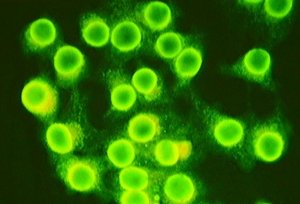Antinuclear antibodies (ANA), also known as ANA (antinuclear antibodies for) or antinuclear antibodies (FAN) are autoantibodies recognizing antigens present in nuclei.
They appear in the serum of patients with connective (or collagen).
 Indications:
Indications:
• Finding a systemic lupus erythematosus (SLE) in front of a photosensitivity, a vespertilio, a non-erosive arthritis, proteinuria, pleurisy, hemolytic anemia.
• Finding a systemic sclerosis before Raynaud’s phenomenon, sclerodactyly, skin infiltration respecting the back and buttocks, esophageal disease.
Sample:
Venous blood clotted.
Method:
Search ANA is indirect immunofluorescence (IIF) on human cultured tumor cells (HEp-2 cells) whose core contains the most human nuclear antigens.
Technical IFI:
After contacting with the suspect serum, the bound antibodies are revealed with an anti-human immunoglobulin labeled with a serum fluochrome.
In case of presence of antinuclear antibodies, the nuclei fluoresce.
Progressive dilutions of the serum of the patient determine the antibody titer.
Typical values:
Negative if <1/20
Positive if> 1/80
The laboratory also specifies the type of fluorescence obtained: Device, homogeneous, speckled and nucleolar.
If a successful search, the type of antibody is determined by other methods (see Antibodies antiantigènes soluble antigens).
Interpretation:
• Serum 90% of patients with LEAD contains antinuclear antibody titres> 1/160 in IIF. Fluorescence is homogeneous.
• High titers, but with a nucleolar staining, are found almost exclusively in systemic sclerosis (60% of cases).
• Antinuclear antibodies are present, but at lower securities in rheumatoid arthritis, Sjogren’s syndrome, chronic hepatitis.

You must be logged in to post a comment.